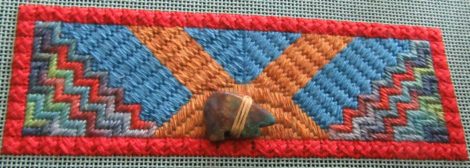
Using overdyed threads in your needlepoint project can be such a hassle. If the project uses them in different areas that reflect each other or that rotate around, you can find yourself with areas that look completely different.
This happens because the threads constantly change colors and the colors you use in one area may not be the same as the colors in a second area — even if all the thread is from the same skein.
Happily we can borrow one of the dyelot techniques to make the colors symmetrical, resulting in areas that look similar if not the same. This reflection technique, seen above, works with any strandable overdyed thread. Here’s how to do it:
- Determine how many strands of the stitching bundle you need and how many areas you have to cover. Here I used Watercolours (3 strands) and have 2 areas to cover. If I had been using a 12-strand silk, I’d use 4 strands. Floss is harder because I have two areas. I would have to split the floss in half and use 3 strands.
- Reserve one part of the thread for each area. If you have more bundles than areas, as is the case here, reserve two bundles and set aside one. If you have more areas than bundles think about how they could be divided so that you have symmetry. If I had four areas, I would need 2 different 2-strand groups to get symmetry. If I had 6 areas I could use all three groups.
- Keep the extra bundles for another project.
Now you know that your threads will match in color because you have divided the threads so they will. But you still need to stitch them in the same sequence to achieve symmetry. To do this you will, if possible, need to stitch the sides simultaneously, as I did here.Take your bundle and split it up. Stitch one area with one part of the bundle. Then thread your needle so the same end as you first used is through the eye, and stitch the other area.
Often the two areas will not have exactly the same number of stitches in a length. This discrepancy will not be noticed in the larger and more dominant overall symmetry.There is one more easy technique to use to get symmetry. It’s called color matching and it will make your overdyed colors flow beautifully.
To do this you need to note the color of the thread when you ended stitching. When picking the next thread to use, look at the ends. Pick a thread with the same color at the end. When threading the needle, thread the opposite end so the matching color will be stitched first. Sometimes you cannot do this, but most of the time it works to create seamless color changes.
This technique was used on this project by Toni Gerdes. Six threads were used on each side. How many of the transitions can you find?
About Janet M Perry
Janet Perry is the Internet's leading authority on needlepoint. She designs, teaches and writes, getting raves from her fans for her innovative techniques, extensive knowledge and generous teaching style. A leading writer of stitch guides, she blogs here and lives on an island in the northeast corner of the SF Bay with her family

I did this on my Zuni Sunset.